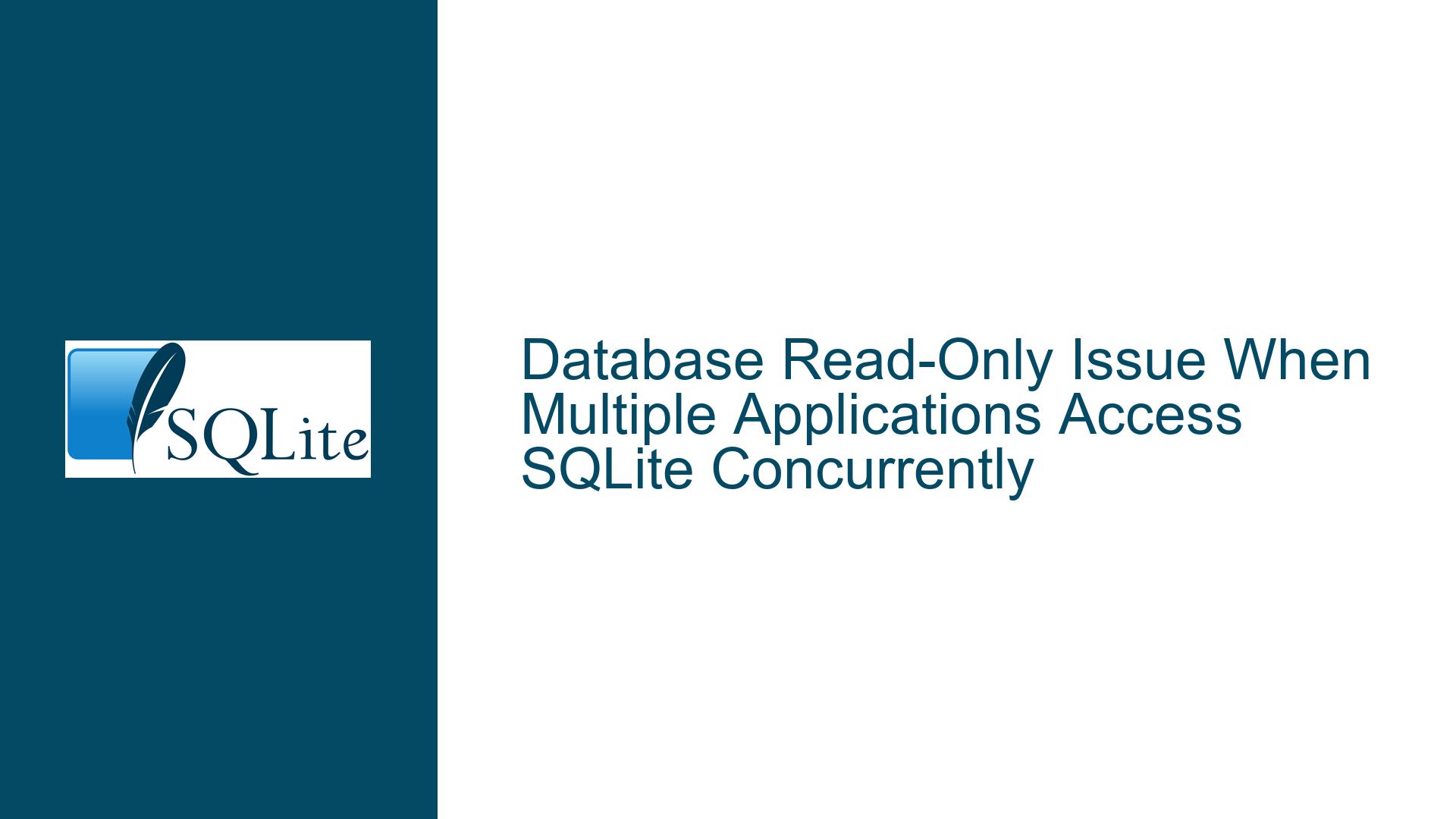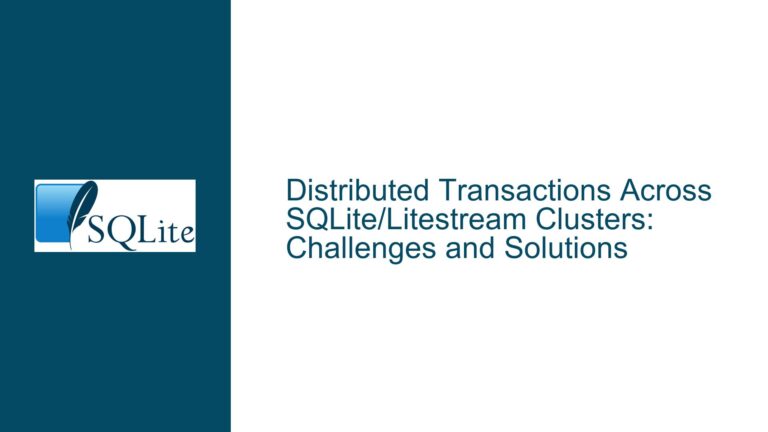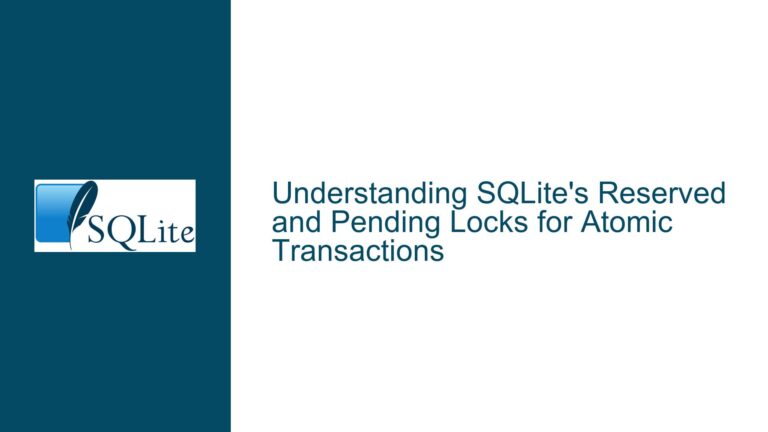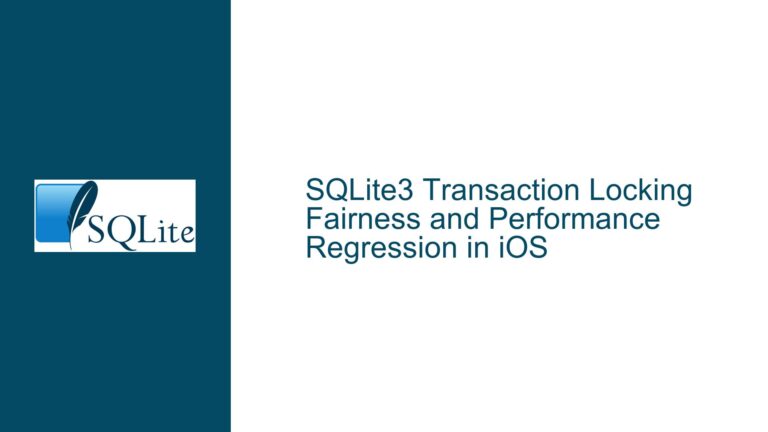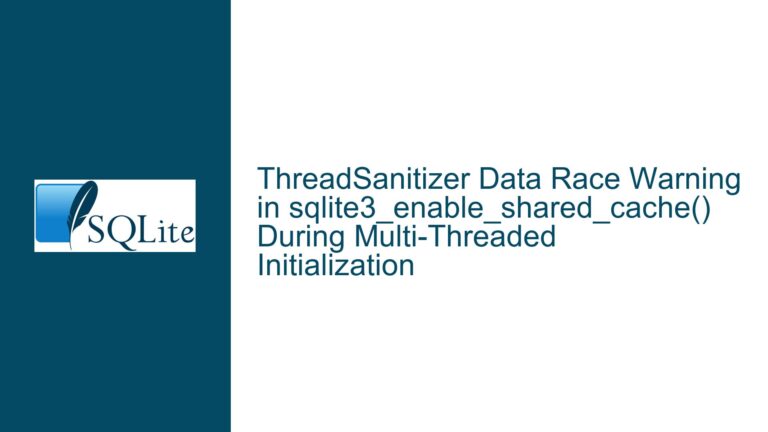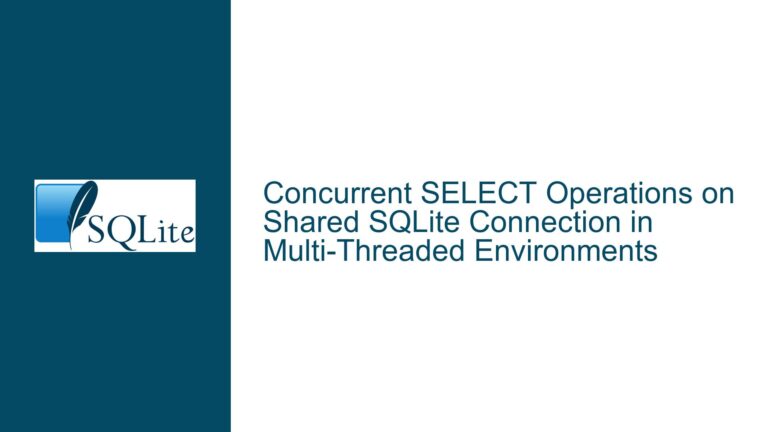Database Read-Only Issue When Multiple Applications Access SQLite Concurrently
Issue Overview: Concurrent Database Access Leading to Read-Only State
The core issue revolves around multiple applications attempting to access the same SQLite database concurrently, resulting in one or more applications encountering a "database is read-only" error. This error is intermittent and not easily reproducible, but it consistently resolves upon restarting the affected application. The database is not configured as read-only, and the issue arises specifically when multiple applications initialize the database simultaneously. The applications in question are written in C++ and Python, utilizing the SQLite library libsqlite3.so.0.8.6 on a Linux system with an ext4 filesystem. The database is configured to use Write-Ahead Logging (WAL) mode in Python, while the C++ code does not explicitly set the journal mode.
The error manifests as an "attempt to write a readonly database" message in the logs, despite the database being writable under normal circumstances. The issue is particularly perplexing because it does not occur consistently, making it challenging to diagnose and resolve. The applications do not perform any direct database writes during initialization, which further complicates the matter. The problem appears to be related to the concurrent initialization of the database by multiple applications, potentially leading to a race condition or a temporary lock that causes one of the applications to perceive the database as read-only.
Possible Causes: Concurrent Initialization and WAL Mode Configuration
The issue likely stems from a combination of factors related to concurrent database access and the configuration of the WAL mode. When multiple applications attempt to initialize the same SQLite database simultaneously, they may interfere with each other’s operations, leading to unexpected behavior. The WAL mode, while designed to improve concurrency, can introduce complexities when multiple processes attempt to access the database at the same time.
One possible cause is that the WAL mode is not consistently applied across all applications. The Python code explicitly sets the database to WAL mode, but the C++ code does not, which could lead to inconsistencies in how the database is accessed. If one application initializes the database in WAL mode while another does not, it could result in a situation where the database is temporarily locked or perceived as read-only by one of the applications.
Another potential cause is related to the SQLite busy timeout setting. The C++ code sets a busy timeout of 30 seconds using sqlite3_busy_timeout, which is intended to handle situations where the database is locked by another process. However, if the timeout is not sufficient to handle the concurrent initialization process, it could result in the database being perceived as read-only. Additionally, the busy timeout only applies to situations where the database is locked, not necessarily to issues arising from WAL mode configuration.
The filesystem itself could also play a role in this issue. The ext4 filesystem, while generally robust, may have specific behaviors or limitations when it comes to handling concurrent access to the same file. If the filesystem is unable to handle the simultaneous initialization requests from multiple applications, it could result in the database being temporarily locked or marked as read-only.
Finally, the issue could be related to the SQLite library version being used (libsqlite3.so.0.8.6). Older versions of SQLite may have bugs or limitations that could contribute to this problem. It is possible that upgrading to a newer version of the SQLite library could resolve the issue, as newer versions often include bug fixes and improvements related to concurrency and WAL mode.
Troubleshooting Steps, Solutions & Fixes: Ensuring Consistent WAL Mode and Handling Concurrent Access
To address the issue of the database being perceived as read-only when multiple applications access it concurrently, several steps can be taken. These steps involve ensuring consistent WAL mode configuration across all applications, optimizing the busy timeout setting, and considering the impact of the filesystem and SQLite library version.
First, it is crucial to ensure that all applications accessing the database are consistently using WAL mode. This can be achieved by explicitly setting the journal mode to WAL in both the Python and C++ code. In the C++ code, this can be done by executing the following SQL statement after opening the database:
sqlite3_exec(dbConnection, "PRAGMA journal_mode=WAL;", nullptr, nullptr, nullptr);
This ensures that all applications are operating in WAL mode, reducing the likelihood of inconsistencies that could lead to the database being perceived as read-only.
Next, the busy timeout setting should be reviewed and potentially adjusted. While the current timeout of 30 seconds may be sufficient in many cases, it may not be adequate for handling the concurrent initialization process. Increasing the timeout to a higher value, such as 60 seconds, could provide additional time for the database to handle concurrent access:
int sqlStatus = sqlite3_busy_timeout(dbConnection, 60000);
Additionally, it may be beneficial to implement a retry mechanism in the code to handle situations where the database is temporarily locked. This could involve wrapping the database initialization code in a loop that retries the operation a certain number of times before giving up:
int retries = 5;
while (retries > 0) {
if (sqlite3_open_v2(fileName, &dbConnection, SQLITE_OPEN_READWRITE | SQLITE_OPEN_CREATE | SQLITE_OPEN_URI, nullptr) == SQLITE_OK) {
break;
}
retries--;
sleep(1); // Wait for 1 second before retrying
}
if (retries == 0) {
// Handle the error, e.g., log an error message and exit
}
This retry mechanism can help mitigate the impact of temporary locks or other transient issues that may occur during concurrent initialization.
The filesystem should also be considered when troubleshooting this issue. While ext4 is generally reliable, it may be worth testing the application on a different filesystem, such as XFS or Btrfs, to see if the issue persists. Additionally, ensuring that the filesystem is properly configured and that there are no underlying issues, such as disk errors or insufficient inodes, can help prevent problems related to concurrent database access.
Finally, upgrading to a newer version of the SQLite library may resolve the issue. Newer versions of SQLite often include bug fixes and improvements related to concurrency and WAL mode, which could address the problem. It is recommended to test the application with the latest stable version of SQLite to see if the issue is resolved.
In conclusion, the issue of the database being perceived as read-only when multiple applications access it concurrently is likely related to inconsistent WAL mode configuration, insufficient busy timeout settings, and potential filesystem or SQLite library limitations. By ensuring consistent WAL mode configuration across all applications, optimizing the busy timeout setting, implementing a retry mechanism, considering the impact of the filesystem, and upgrading to a newer version of the SQLite library, the issue can be effectively addressed and resolved.
